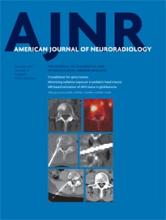Research ArticleADULT BRAIN
Open Access
Quantitative MRI for Analysis of Active Multiple Sclerosis Lesions without Gadolinium-Based Contrast Agent
I. Blystad, I. Håkansson, A. Tisell, J. Ernerudh, Ö. Smedby, P. Lundberg and E.-M. Larsson
American Journal of Neuroradiology January 2016, 37 (1) 94-100; DOI: https://doi.org/10.3174/ajnr.A4501
I. Blystad
aFrom the Departments of Radiology and Medical and Health Sciences (I.B., Ö.S.)
bCentre for Medical Image Science and Visualization (I.B., A.T., Ö.S., P.L., E.-M.L.)
I. Håkansson
cDepartments of Neurology and Clinical and Experimental Medicine (I.H.)
A. Tisell
bCentre for Medical Image Science and Visualization (I.B., A.T., Ö.S., P.L., E.-M.L.)
dDepartments of Radiation Physics and Medical and Health Sciences (A.T., P.L., E.-M.L.)
J. Ernerudh
eDepartments of Clinical Immunology and Transfusion Medicine and Clinical and Experimental Medicine (J.E.), Linköping University, Linköping Sweden
Ö. Smedby
aFrom the Departments of Radiology and Medical and Health Sciences (I.B., Ö.S.)
bCentre for Medical Image Science and Visualization (I.B., A.T., Ö.S., P.L., E.-M.L.)
P. Lundberg
bCentre for Medical Image Science and Visualization (I.B., A.T., Ö.S., P.L., E.-M.L.)
dDepartments of Radiation Physics and Medical and Health Sciences (A.T., P.L., E.-M.L.)
E.-M. Larsson
bCentre for Medical Image Science and Visualization (I.B., A.T., Ö.S., P.L., E.-M.L.)
dDepartments of Radiation Physics and Medical and Health Sciences (A.T., P.L., E.-M.L.)
fDepartment of Surgical Sciences/Radiology (E.-M.L.), Uppsala University, Uppsala, Sweden.

References
- 1.↵
- 2.↵
- Polman CH,
- Reingold SC,
- Banwell B, et al
- 3.↵
- 4.↵
- Barkhof F
- 5.↵
- 6.↵
- Prince MR,
- Zhang H,
- Zou Z, et al
- 7.↵
- Kanda T,
- Ishii K,
- Kawaguchi H, et al
- 8.↵
- Errante Y,
- Cirimele V,
- Mallio CA, et al
- 9.↵
- 10.↵
- Wiggermann V,
- Hernández Torres E,
- Vavasour IM, et al
- 11.↵
- Levesque IR,
- Giacomini PS,
- Narayanan S, et al
- 12.↵
- 13.↵
- Warntjes JB,
- Dahlqvist O,
- Lundberg P
- 14.↵
- 15.↵
- Shinohara RT,
- Goldsmith J,
- Mateen FJ, et al
- 16.↵
- 17.↵
- Eisele P,
- Szabo K,
- Griebe M, et al
- 18.↵
- Deoni SC,
- Peters TM,
- Rutt BK
- 19.↵
- Papanikolaou N,
- Papadaki E,
- Karampekios S, et al
- 20.↵
- MacKay AL,
- Vavasour IM,
- Rauscher A, et al
- 21.↵
- 22.↵
- Ormerod IE,
- Bronstein A,
- Rudge P, et al
- 23.↵
- 24.↵
- Filippi M,
- Rocca MA,
- Barkhof F, et al
- 25.↵
- Cotton F,
- Weiner HL,
- Jolesz FA, et al
- 26.↵
- 27.↵
- 28.↵
- Warntjes JB,
- Tisell A,
- Landtblom AM, et al
- 29.↵
- Vågberg M,
- Lindqvist T,
- Ambarki K, et al
In this issue
American Journal of Neuroradiology
Vol. 37, Issue 1
1 Jan 2016
Advertisement
I. Blystad, I. Håkansson, A. Tisell, J. Ernerudh, Ö. Smedby, P. Lundberg, E.-M. Larsson
Quantitative MRI for Analysis of Active Multiple Sclerosis Lesions without Gadolinium-Based Contrast Agent
American Journal of Neuroradiology Jan 2016, 37 (1) 94-100; DOI: 10.3174/ajnr.A4501
0 Responses
Jump to section
Related Articles
- No related articles found.
Cited By...
- Decoding the Best Automated Segmentation Tools for Vascular White Matter Hyperintensities in the Aging Brain: A Clinicians Guide to Precision and Purpose
- Comparison between tools for automatic segmentation of white matter hyperintensities of presumed vascular origin in aging: which one, how and why to choose the most suitable for your purpose?
- Quantitative MRI in Multiple Sclerosis: From Theory to Application
- 3D Quantitative Synthetic MRI in the Evaluation of Multiple Sclerosis Lesions
- The Use of Noncontrast Quantitative MRI to Detect Gadolinium-Enhancing Multiple Sclerosis Brain Lesions: A Systematic Review and Meta-Analysis
- Utility of a Multiparametric Quantitative MRI Model That Assesses Myelin and Edema for Evaluating Plaques, Periplaque White Matter, and Normal-Appearing White Matter in Patients with Multiple Sclerosis: A Feasibility Study
- T1 Recovery Is Predominantly Found in Black Holes and Is Associated with Clinical Improvement in Patients with Multiple Sclerosis
- Synthetic MRI in the Detection of Multiple Sclerosis Plaques
- Magnetic Susceptibility from Quantitative Susceptibility Mapping Can Differentiate New Enhancing from Nonenhancing Multiple Sclerosis Lesions without Gadolinium Injection
- Quantitative Susceptibility Mapping and R2* Measured Changes during White Matter Lesion Development in Multiple Sclerosis: Myelin Breakdown, Myelin Debris Degradation and Removal, and Iron Accumulation
This article has not yet been cited by articles in journals that are participating in Crossref Cited-by Linking.
More in this TOC Section
Similar Articles
Advertisement











